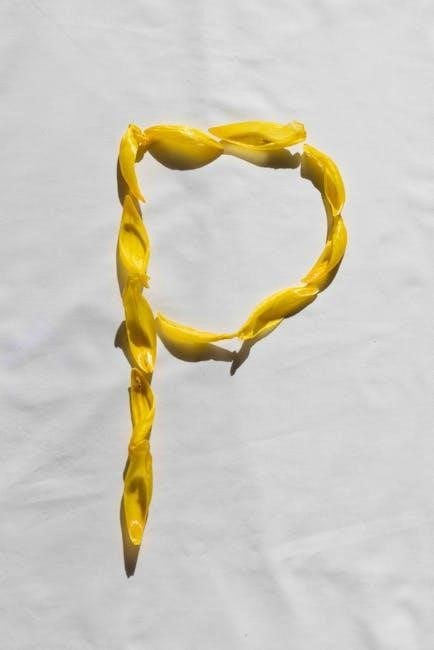P&I Diagrams are essential tools in process industries, providing a visual representation of systems and components․ They use standardized symbols to depict equipment, instrumentation, and piping, ensuring clarity and consistency․ These diagrams are crucial for engineers, designers, and operators to understand process flows and equipment interactions effectively․
Standard P&I Symbols
P&I Diagrams use standardized symbols to represent equipment, instrumentation, valves, and piping components․ These symbols ensure consistency and clarity in process documentation, adhering to industry standards like ISO 10628․ They are categorized for easy identification and application across projects․
Piping Symbols
Piping symbols are fundamental components of P&I diagrams, representing various piping elements such as pipes, fittings, and connections․ These symbols are standardized to ensure uniformity and clarity․ Common piping symbols include straight pipes, elbows, tees, flanges, valves, and reducers․ Each symbol is designed to clearly depict the type of connection or fitting, aiding engineers and technicians in understanding the flow of materials․ For instance, a flanged connection is represented by a specific icon, while a welded joint uses another․ These symbols are essential for maintaining consistency across projects and industries, ensuring that everyone involved in the process can interpret the diagram accurately․ The use of standardized piping symbols also helps in reducing errors during the design, construction, and maintenance phases of a project․ By providing a clear visual representation, piping symbols play a crucial role in the effectiveness of P&I diagrams․
Valve Symbols
Valve symbols are critical elements in P&I diagrams, representing various types of valves and their functions within a system․ These symbols are standardized to ensure clarity and consistency across industries․ Common valve symbols include gate valves, globe valves, butterfly valves, ball valves, and check valves․ Each symbol is designed to convey specific information about the valve’s operation, such as whether it is manual or actuated, and its flow direction․ For example, a fail-open or fail-close symbol indicates the valve’s default position in case of system failure․ These symbols are essential for understanding how valves control the flow of materials in a process system․ Additionally, valve symbols often include notations for actuators, such as pneumatic or hydraulic operators, which provide further detail about the valve’s mechanism․ Standardized valve symbols ensure that engineers, operators, and maintenance personnel can quickly interpret the diagram and perform their tasks efficiently․ This consistency is vital for maintaining safety and operational efficiency in process industries․
Instrumentation Symbols
Instrumentation symbols are fundamental components of P&I diagrams, representing the tools and devices used to measure, monitor, and control process variables․ These symbols are standardized to ensure universal understanding across industries․ Common examples include temperature sensors, pressure transmitters, flow meters, and level indicators․ Each symbol is designed to clearly indicate the type of measurement or control function, such as PI for pressure indicators or TI for temperature indicators․ Instrumentation symbols also denote the connection types, such as wiring or pneumatic lines, and may include details about the device’s location or integration into the control system․ For instance, a control valve symbol combined with an actuator symbol indicates a motor-operated valve․ These symbols are essential for understanding how process parameters are monitored and regulated, ensuring efficient and safe operations․ By standardizing instrumentation symbols, P&I diagrams provide a clear and concise means of communication among engineers, technicians, and operators, facilitating accurate system design, maintenance, and troubleshooting․
Equipment Symbols
Equipment symbols are a critical part of P&I diagrams, representing the machinery and hardware used in process systems․ These symbols are standardized to depict items like pumps, compressors, tanks, heat exchangers, and vessels․ Each symbol is designed to clearly convey the type of equipment and its role in the process․ For example, a pump symbol may include arrows to indicate fluid flow direction, while a heat exchanger symbol might show coils or plates to represent its internal structure․ Equipment symbols also vary in complexity, from simple representations of tanks and drums to detailed depictions of mixers and agitators․ These symbols are organized in P&I diagrams to illustrate how equipment interacts within the process, ensuring clarity for engineers and operators․ The use of standardized equipment symbols in P&I diagrams enhances communication and reduces ambiguity, making it easier to design, maintain, and troubleshoot systems․ By referencing a P&I diagram symbols PDF, users can quickly identify and interpret equipment symbols, ensuring accurate system documentation and operation․

Reading and Interpreting P&I Diagrams
Reading P&I diagrams requires understanding standardized symbols and their relationships․ Start by identifying key components like equipment, valves, and instruments․ Follow the flow of materials through piping and instrumentation, and interpret control loops and annotations for process understanding․ Always reference a P&I diagram symbols PDF for accurate interpretation․
Understanding Layout
Understanding the layout of P&I diagrams is crucial for effective interpretation․ These diagrams are visually structured to represent process systems clearly, using standardized symbols and conventions․ The layout typically organizes components hierarchically, separating process equipment, piping, and instrumentation into distinct sections․ This structured approach ensures that the flow of materials and signals is easy to follow․
Key elements in the layout include equipment symbols, valve representations, and instrumentation tags․ These are arranged to reflect their physical and functional relationships in the process․ Lines and connections are simplified to avoid clutter, while annotations provide additional details․ The layout may also incorporate control systems, showing how instruments interact with valves and equipment․
Tools like EdrawMax simplify the creation of P&I diagrams, offering libraries of symbols and templates․ These tools ensure consistency in layout design, making diagrams more readable․ Proper layout is essential for troubleshooting, maintenance, and operational planning, as it provides a clear visual representation of the process system․
Recognizing Common Symbols
Recognizing common symbols in P&I diagrams is essential for accurate interpretation․ These symbols represent various components such as pipes, valves, instruments, and equipment․ Standardized symbols ensure consistency across industries, making diagrams universally understandable․ Common piping symbols include lines for process, utility, and drain flows, while valve symbols differentiate between types like gate, globe, and butterfly valves․ Instrumentation symbols depict sensors, controllers, and transmitters, often labeled with tags for clarity․ Equipment symbols represent items like pumps, heat exchangers, and tanks, providing a clear visual representation of the process system․
These symbols are typically categorized into groups such as piping, valves, instrumentation, and equipment․ Standards like ISA S5․1 and ISO 10628 define their appearance and usage․ Familiarity with these symbols allows engineers and operators to quickly identify components and understand their roles in the process․ Resources like P&I diagram symbols PDFs provide comprehensive guides for reference and training, ensuring proper recognition and application of these symbols in real-world scenarios․
Creating a P&I Diagram
Creating a P&I Diagram involves careful planning and adherence to industry standards․ Start by gathering process information, including equipment and instrumentation details․ Use specialized software like AutoCAD or EdrawMax with P&I symbol libraries․ Ensure symbols are accurate and consistent, referencing a P&I Diagram Symbols PDF for guidance․ Plan the layout logically, placing major equipment first, then adding piping and instrumentation․ Include legends and notes for clarity․ Collaborate with engineers and designers for complex systems, and review the diagram for accuracy․ Save the final version in a shareable format like PDF and update it regularly to reflect process changes․ Regular updates ensure the diagram remains a reliable reference for operations and maintenance․
Design Considerations
When creating a P&I Diagram, several design considerations must be prioritized to ensure clarity and functionality․ Standardization is key; use universally recognized symbols from a P&I Diagram Symbols PDF to maintain consistency across the diagram․ Clear labeling and annotation are essential, as they provide critical information about equipment, valves, and instrumentation․ The layout should be logical, with major components positioned prominently and piping flows intuitively represented․ Avoid clutter by grouping related elements and using color coding for different process streams or systems․ Ensure readability by selecting appropriate font sizes and spacing․ Incorporate legends to explain symbols and abbreviations, making the diagram accessible to all users․ Scalability is another important factor; the diagram should be navigable in both digital and printed formats․ Adherence to industry standards, such as ISO 10628 or ISA S5․1, ensures compatibility and accuracy․ Regularly review and update the diagram to reflect process changes, maintaining its relevance and reliability as a reference tool․
Tools and Software
Creating accurate P&I Diagrams requires the use of specialized tools and software․ Popular options include AutoCAD, SmartPlant P&ID, and EdrawMax, which offer extensive libraries of P&I Diagram Symbols in PDF format․ These tools provide drag-and-drop functionality, enabling users to quickly assemble diagrams with standardized symbols for pipes, valves, instruments, and equipment․ Lucidchart and Visio are also widely used for their user-friendly interfaces and collaboration features․ Additionally, EdrawMax Online allows direct access to a comprehensive P&I Symbols Library, streamlining the design process․ Many software solutions support exporting diagrams in PDF format, ensuring compatibility and ease of sharing․ These tools not only enhance efficiency but also ensure compliance with industry standards, such as ISO 10628 and ISA S5․1․ By leveraging these resources, engineers and designers can produce high-quality P&I Diagrams that are both accurate and easy to interpret․

A P&I Diagram Symbols PDF serves as a comprehensive reference guide, detailing standardized symbols for pipes, valves, instruments, and equipment․ It provides clear visuals and descriptions, ensuring consistency in diagram creation․ Essential for engineers, designers, and students working with process systems, these PDFs are widely available for download․
Sources for Download
Several reliable sources offer free P&I Diagram Symbols PDF downloads, catering to engineers, students, and professionals․ Websites like Lngacademy and EdrawMax provide comprehensive libraries of industry-standard symbols․ These resources include detailed documentation for pipes, valves, instruments, and equipment, ensuring consistency in diagram creation․ Additionally, platforms like ISA S5․1 and ISO 10628 offer standardized symbol sets․ Many engineering forums and educational sites also share downloadable PDFs, making it easy to access these tools․ These resources are essential for creating accurate and professional P&I Diagrams, streamlining workflows in process industries․
Applications and Use Cases
P&I Diagrams are widely used in oil & gas, chemical plants, and power generation for designing, operating, and maintaining process systems․ They aid in troubleshooting, training, and compliance, ensuring efficient communication among engineers and operators in process industries․
Role in Process Industries
P&I Diagrams play a critical role in process industries by providing a clear, standardized visual representation of complex systems․ They are essential for designing, operating, and maintaining plants, ensuring safety, efficiency, and compliance with industry standards․ These diagrams facilitate communication among engineers, operators, and technicians, enabling effective collaboration and decision-making․ They are indispensable for troubleshooting, as they provide a detailed overview of system components and their interactions․ Additionally, P&I Diagrams are used in training programs to educate personnel on system operations and safety procedures․ Their role extends to regulatory compliance, as they serve as official documentation for audits and inspections․ By standardizing symbols and layouts, P&I Diagrams ensure consistency across projects, reducing errors and improving overall process reliability․ They are integral to the lifecycle of process systems, from initial design to ongoing maintenance and optimization․

